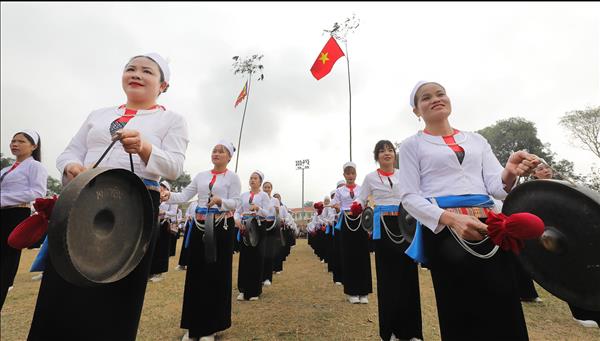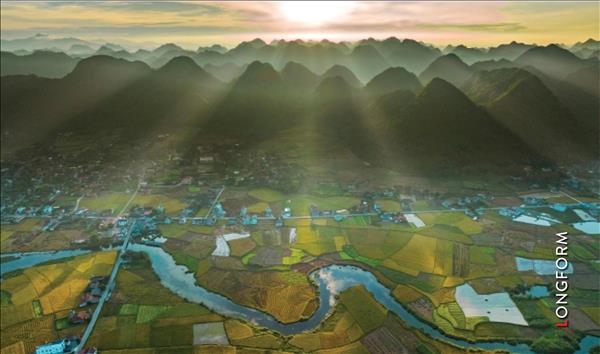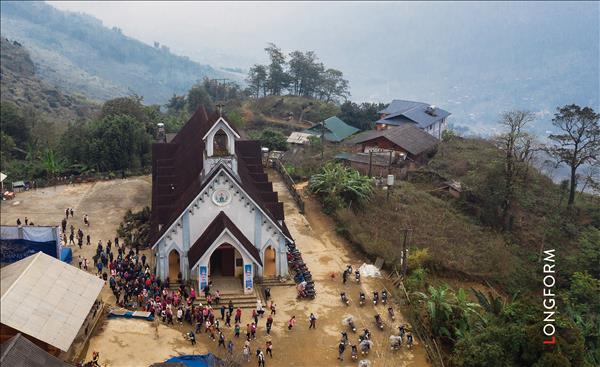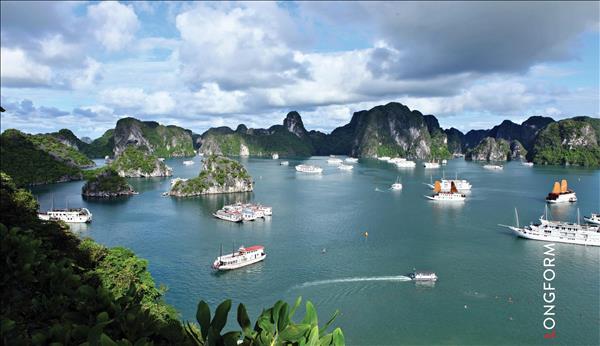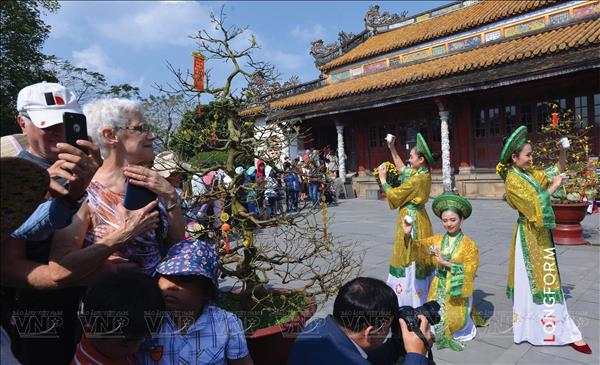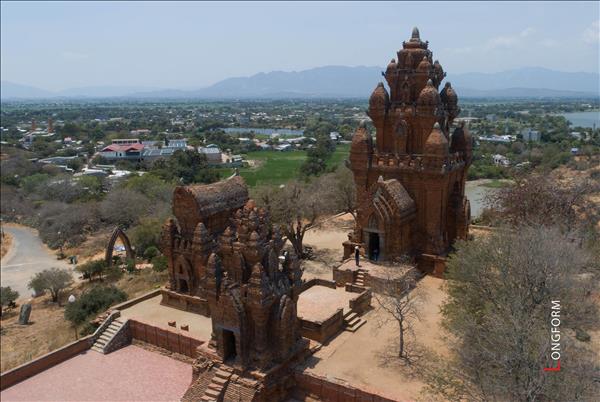Economic potentials
Phu Yen is widely known nationwide for its fishing development, especially tuna fishing. The local people call tuna the “humpback-cow” fish because this kind of fish has a hump on its back and red meat like beef.
Local people recalled that in 1994 some fishermen in Phu Cau fishing village in Tuy Hoa City by chance caught tuna during their trip to the sea to catch flying fish. Since then, tuna fishing has developed more professionally and quickly spread out into other south-central coastal provinces.
To date, Vietnamese tuna has been exported to nearly 90 countries and territories, including the three major markets of the United States, the EU and Japan.
Tuna fishing in Phu Yen has been selected by the Government as the key fundament in the plan to develop off-shore fishing. In 2011, Phu Yen tuna was granted a trade mark “Phuyen Tuna” by the Vietnam’s National Office of Intellectual Property, the first brand of this kind in Vietnam.
To develop off-shore fishing, the province has now a fleet of more than 600 ships of large capacity. Many local people have different generations of family members who do tuna fishing to earn their living and also contribute to defending the country’s sea sovereignty.
Old fisherman Phan Thuan is among them. After 50 years in off-shore fishing, he retired from fishing, but now keeps working as Chairman of the Ward 6’s Fishing Group in Tuy Hoa City. His five children have also become tuna fishermen.
In Dong Tac fishing village, Phu Dong Ward, a twin of the Luong Cong Dongs has the nickname “the Sea Wolf” due to their good capacity and skills in fishing. Each owns a 400CV-powered boat, and both have supported dozens of local fishermen during their long fishing trips offshore.
Besides fishing, Phu Yen Province has many advantages in aquatic culture with high-quality products including lobsters, white-leg shrimp, sweet snails and grouper. The annual output can reach over 10,000tonnes.
The province has different kinds of transportation -- land, water and railway, air and sea routes. Located at the gate to the sea in the Central Highlands, and bordered with localities having dynamic economic powers including Binh Dinh and Khanh Hoa provinces, Phu Yen has many advantages in developing its economy.
At present, the three industrial parks; Hoa Hiep, An Phu and North-East Song Cau with their completed infrastructure have attracted lots of domestic and foreign investment. They provide jobs to many labourers who can use new technology in making products for export and high-quality consumer goods in replacement of imported ones.
Different small-sized industrial and handicraft production groups in many districts have played their role in preserving and developing traditional crafts. Running on an appropriate scale, but fully taking advanges of local raw materials, those production groups help solve employment problems in rural areas.
According to Le Van Thanh, Head of the Management Board of Phu Yen Province’s Economic Zones, in the future when construction of the Vung Ro Oil Refinery is completed, the province will attract many other projects in such areas as fertilizers, oil and gas, etc., making it become a huge industrial hub in the country’s central region.
To date, the province has 39 ongoing foreign invested projects with a total investment of 318.5 million dollars, and 114 domestically-invested projects worth more than 9.7 trillion dong.
Tourism potential
Phu Yen has been endowed by nature with a peaceful and romantic environment that has attracted many visitors. The city of Tuy Hoa has sheltered local residents’ houses amid green fields and around the Chop Chai Mountain. Clear and blue-water beaches stretch out with white sand dunes and wild rock plates -- all making the location a magnificent work of nature. The mossy and serene Mang Lang Temple is one of the local beauty-spots, creating a unique beauty for the local scenery.
Phu Yen reminds many visitors of the Ghenh Da Dia, the overlapped rocky plates in An Ninh Dong Commune of Tuy An District. It is truly a strange geological scene and said to be second-to-none in Vietnam. Seen from afar, it is close to the coast and always splashed by sea waves, the rocky columns look like a huge beehive, built with many rocky plates of different shapes and sizes and interlocked in layers.
Meanwhile, O Loan Lagoon, also in Tuy An District and a national-level beauty-spot, attracts visitors due to its romantic feel. Seen from above, the lake looks like a big bird ready to fly to the sky with its huge wings. There are lots of special aquatic products living in the lake, of which the O Loan blood cockles are particularly well known in the region.
Built near the peaceful Ba River, the Mang Lang Temple with its nearly 120 year-old history, has preserved a national precious item, the Cathechismvs book, the first national language printed book of the Vietnamese made by Priest Alexandre de Rhodesin 1651 in Rome.
Going southwards, the Vung Ro Bay in Hoa Xuan Nam Commune of Dong Hoa district has deep blue water. The bay is surrounded by the Ca Pass, Da Bia Mountain and Hon Ba Mountain. Visitors can take tours to see the beauty of the ocean or climb Da Bia Mountain always covered in white mist.
Not too far from Vung Ro Bay is Dai Lanh Cape, the easternmost pole of the country’s mainland where the first rays of the dawn comes to the S-shaped country of Vietnam.
With its huge sea potential and natural beauty-spots that have been depicted in many poems, songs and movies, Phu Yen Province has plenty of opportunities for further development
|
““Each year, Phu Yen Province processes 6,000tonnes of tuna and 3,000tonnes of cuttlefish. In 2016, it has plans to build 185 new boats, along with providing other logistic services and upgrading 465 old boats. By 2020, it will have a fleet of 315 new boats and 705 upgraded boats”. (Le Van Truc, Vice-Chairman of Phu Yen Province People’s Committee) |
Local people recalled that in 1994 some fishermen in Phu Cau fishing village in Tuy Hoa City by chance caught tuna during their trip to the sea to catch flying fish. Since then, tuna fishing has developed more professionally and quickly spread out into other south-central coastal provinces.
To date, Vietnamese tuna has been exported to nearly 90 countries and territories, including the three major markets of the United States, the EU and Japan.
Tuna fishing in Phu Yen has been selected by the Government as the key fundament in the plan to develop off-shore fishing. In 2011, Phu Yen tuna was granted a trade mark “Phuyen Tuna” by the Vietnam’s National Office of Intellectual Property, the first brand of this kind in Vietnam.
To develop off-shore fishing, the province has now a fleet of more than 600 ships of large capacity. Many local people have different generations of family members who do tuna fishing to earn their living and also contribute to defending the country’s sea sovereignty.
|
Tuna fishing in Phu Yen contributed to the protection of Vietnam’s sea and island sovereignty. Photo: Le Minh/VNP 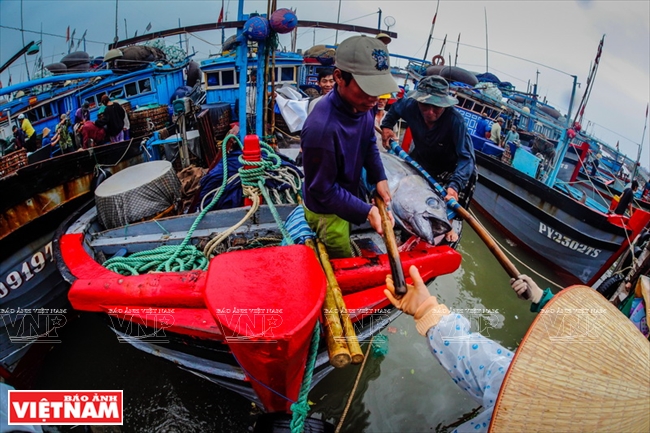 Phu Yen has great potential for developing the sea economy and is known for tuna fishing in Vietnam. Photo: VNP’s file 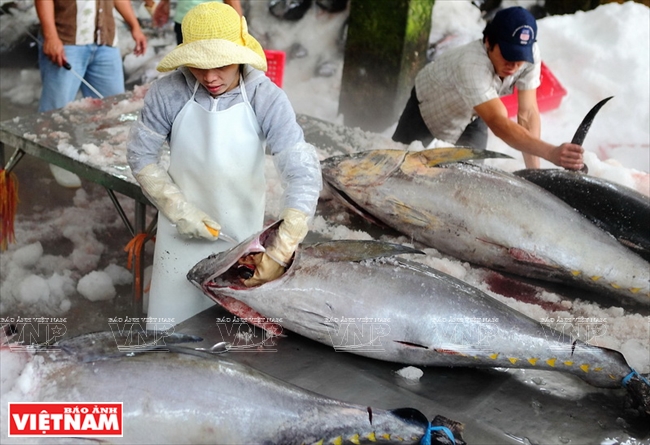 Processing tuna at a factory in Phu Yen. Photo: VNP’s file 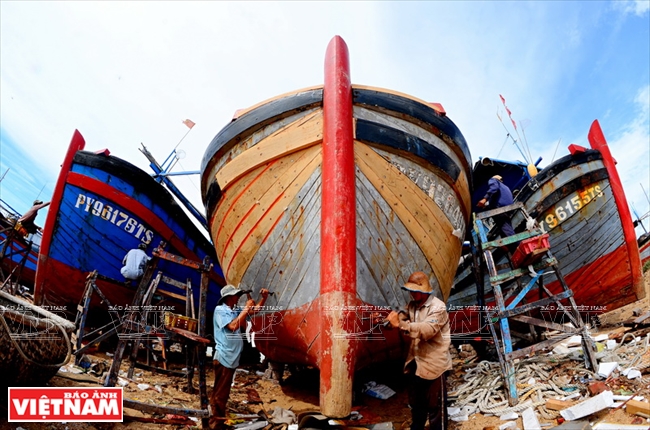 Fishermen repair their boat in preparation for a long fishing trip. Photo: Le Minh/VNP Phu Yen Province has many advantages in aquaculture such as raising lobsters. Photo: Thong Hai/VNP Lobster raising is now contributing significantly to the seafood industry in Phu Yen Province. Photo: Thong Hai/VNP 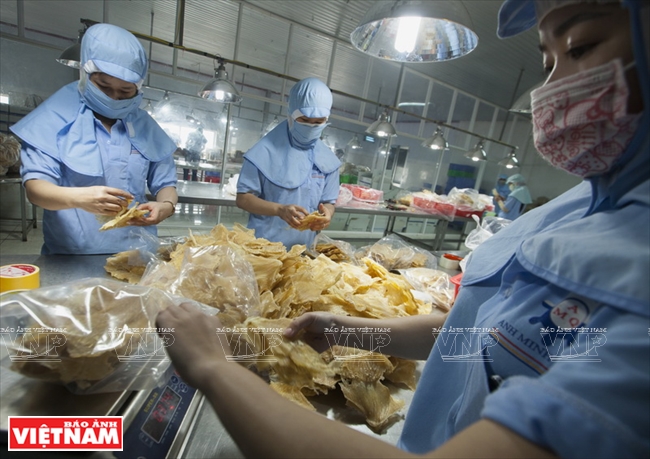 Processing dried Unicorn filefish for export to South Korea at Anh Minh Quan Co.,Ltd. Photo: Thong Hai/VNp |
Old fisherman Phan Thuan is among them. After 50 years in off-shore fishing, he retired from fishing, but now keeps working as Chairman of the Ward 6’s Fishing Group in Tuy Hoa City. His five children have also become tuna fishermen.
In Dong Tac fishing village, Phu Dong Ward, a twin of the Luong Cong Dongs has the nickname “the Sea Wolf” due to their good capacity and skills in fishing. Each owns a 400CV-powered boat, and both have supported dozens of local fishermen during their long fishing trips offshore.
| Besides fishing, Phu Yen Province has many advantages in aquatic culture with high-quality products including lobsters, white-leg shrimp, sweet snails and grouper. The annual output can reach over 10,000tonnes.. |
The province has different kinds of transportation -- land, water and railway, air and sea routes. Located at the gate to the sea in the Central Highlands, and bordered with localities having dynamic economic powers including Binh Dinh and Khanh Hoa provinces, Phu Yen has many advantages in developing its economy.
At present, the three industrial parks; Hoa Hiep, An Phu and North-East Song Cau with their completed infrastructure have attracted lots of domestic and foreign investment. They provide jobs to many labourers who can use new technology in making products for export and high-quality consumer goods in replacement of imported ones.
Different small-sized industrial and handicraft production groups in many districts have played their role in preserving and developing traditional crafts. Running on an appropriate scale, but fully taking advanges of local raw materials, those production groups help solve employment problems in rural areas.
According to Le Van Thanh, Head of the Management Board of Phu Yen Province’s Economic Zones, in the future when construction of the Vung Ro Oil Refinery is completed, the province will attract many other projects in such areas as fertilizers, oil and gas, etc., making it become a huge industrial hub in the country’s central region.
To date, the province has 39 ongoing foreign invested projects with a total investment of 318.5 million dollars, and 114 domestically-invested projects worth more than 9.7 trillion dong.
Tourism potential
Phu Yen has been endowed by nature with a peaceful and romantic environment that has attracted many visitors. The city of Tuy Hoa has sheltered local residents’ houses amid green fields and around the Chop Chai Mountain. Clear and blue-water beaches stretch out with white sand dunes and wild rock plates -- all making the location a magnificent work of nature. The mossy and serene Mang Lang Temple is one of the local beauty-spots, creating a unique beauty for the local scenery.
Phu Yen reminds many visitors of the Ghenh Da Dia, the overlapped rocky plates in An Ninh Dong Commune of Tuy An District. It is truly a strange geological scene and said to be second-to-none in Vietnam. Seen from afar, it is close to the coast and always splashed by sea waves, the rocky columns look like a huge beehive, built with many rocky plates of different shapes and sizes and interlocked in layers.
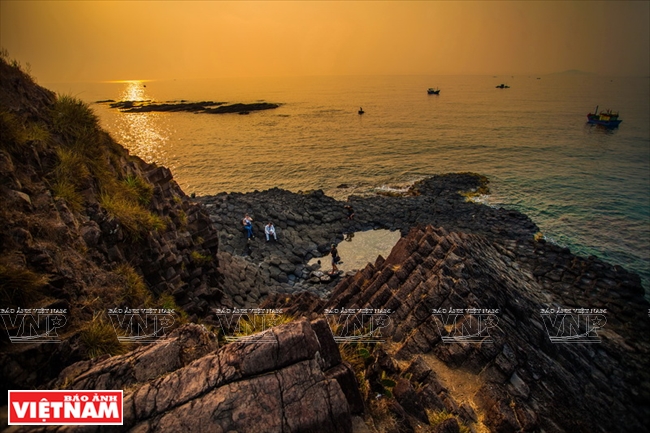 Ghenh Da Dia (Rapids of Stone Plates) with strange hexagon shaped rock formation is a unique landscape of Vietnam. Photo: Trong Dat/VNP 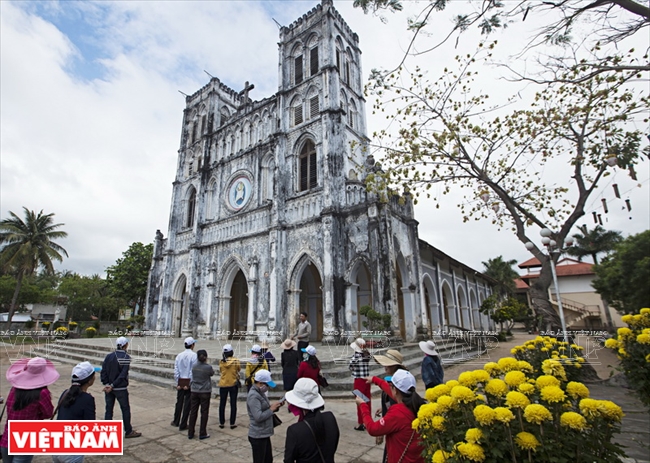 Mang Lang Temple, which dates back nearly 120 years with ancient architecture, presents the signature culture of Phu Yen. Photo: Thong Hai/VNP Nhan Tower, a cultural symbol of Phu Yen. Photo: Thong Hai/VNP 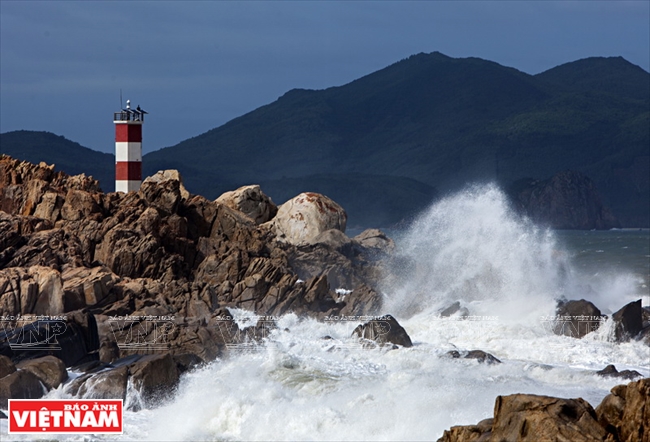 The breathtaking scenery at Ghenh Den (Rapids of Lighthouse), An Chan Commune, Tuy An District. Photo: Thong Hai/VNP 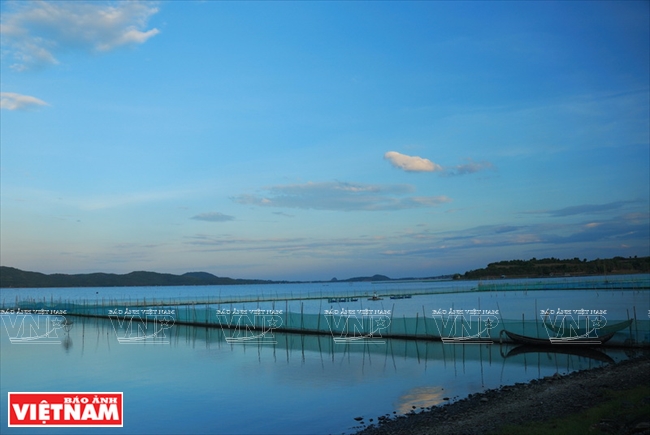 O Loan Lagoon is national beautiful scenery. Photo: VNP’s file |
|
The number of tourists to Phu Yen Province during the 2011-2015 period rose by 20% annually on average, of which foreign visitors made up a 10% increase. Local tourism increased 30%. In 2015 alone, there were about 900,000 first time tourists visiting the province, with more than 30,000 foreigners.Tourism reached over 850 billion dong. |
Built near the peaceful Ba River, the Mang Lang Temple with its nearly 120 year-old history, has preserved a national precious item, the Cathechismvs book, the first national language printed book of the Vietnamese made by Priest Alexandre de Rhodesin 1651 in Rome.
Going southwards, the Vung Ro Bay in Hoa Xuan Nam Commune of Dong Hoa district has deep blue water. The bay is surrounded by the Ca Pass, Da Bia Mountain and Hon Ba Mountain. Visitors can take tours to see the beauty of the ocean or climb Da Bia Mountain always covered in white mist.
Not too far from Vung Ro Bay is Dai Lanh Cape, the easternmost pole of the country’s mainland where the first rays of the dawn comes to the S-shaped country of Vietnam.
With its huge sea potential and natural beauty-spots that have been depicted in many poems, songs and movies, Phu Yen Province has plenty of opportunities for further development
Story: Nguyen Vu Thanh Dat
Photos: Thong Hai, Le Minh, Trong Dat & VNP’s files
Photos: Thong Hai, Le Minh, Trong Dat & VNP’s files

